The Ratio Method

The ratio method is a technique used in poker to evaluate the likelihood of completing a winning hand based on the cards you need, known as “outs.” By comparing the number of outs to the total number of unseen cards, players can determine the odds of hitting a desirable card.
This method helps players decide whether calling a bet is mathematically justified by weighing these odds against the pot odds. In essence, the ratio method allows players to make informed decisions that can maximize long-term profitability.
Example scenario
You’ve ended up seeing a flop with Ace of Spades8 of Spades.
The flop has fallen 2 of Spades7 of HeartsJack of Spades, and you’ve found yourself drawing to the nut flush.
By the time the action is around to you, there are only two players still in the pot – you and one opponent. The pot is $80, and the villain fires in a $20 bet.
Calculating card odds
The first thing you need to do here is calculate the Card Odds. We need to work out how likely we are to catch another spade on the turn. The easiest way to do this is to work out the ratio of cards in the deck that we don’t want to see to the cards that we do want to see. The cards that we do want to see are called ‘outs’.
We already know 5 cards that can’t come out: Ace of Spades8 of Spades2 of Spades7 of HeartsJack of Spades.
Out of a deck of 52, that leaves us with 47 unknown cards.
Given that there are 13 spades in a deck, and we already know that four of them are out, that leaves 9 spades still unaccounted for.
This means we have 9 outs. (Keep in mind, we could potentially have more – if you think your opponent is betting on a pair of Jacks then an Ace of any suit would give you the lead). For now, though, let’s keep it simple and draw to the flush.
Any one of the 9 spades still in the deck will make us our nut flush. Any of the other 38 cards that could come out, won’t.
This gives us a ratio of 38:9, or roughly 4:1.
Weighing card odds against pot odds
Now that we know that the odds of hitting our spade and making our flush are roughly 4:1, we need to make a call on whether this justifies calling our opponent’s bet.
They’ve bet $20 into a pot of $80, making the total pot $100. What this means is that you are calling a bet of $20 for a chance to win $100.
This gives us odds of 100:20 or 5:1.
- Our Card Odds are 4:1
- Our Pot Odds are 5:1
We have odds to call here. Scratching your head?
The odds we are getting from the pot are bigger than the odds that we will hit our flush on the turn. What this means is that over the course of time, if we continually made this call, we would end up making more money than we would lose.
Example calculation using the ratio method
With Card Odds of 4:1, for every four times we don’t hit our flush, there will be one time we do. If the bet is $20, then over the course of those 4 times we won’t hit our flush, we’re going to lose $80 calling. The one time we do hit it, we’re going to make $100 – you’re going to make back your $80 plus an extra $20!